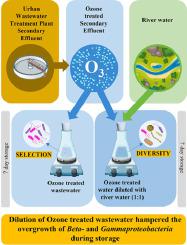Water Research ( IF 12.8 ) Pub Date : 2021-12-04 , DOI: 10.1016/j.watres.2021.117932 Sara Ribeirinho-Soares 1 , Nuno F F Moreira 2 , Cátia Graça 3 , M Fernando R Pereira 3 , Adrián M T Silva 3 , Olga C Nunes 1

|
Improving the chemical and biological quality of treated wastewater is particularly important in world regions under water stress. In these regions, reutilization of wastewater is seen as an alternative to reduce water demand, particularly for agriculture irrigation. In a reuse scenario, the treated wastewater must have enough quality to avoid chemical and biological contamination of the receiving environment. Ozonation is among the technologies available to efficiently remove organic micropollutants and disinfect secondary effluents, being implemented in full-scale urban wastewater treatment plants worldwide. However, previous studies demonstrated that storage of ozone treated wastewater promoted the overgrowth of potentially harmful bacteria, putting at risk its reutilization, given for instance the possibility of contaminating the food-chain. Therefore, this study was designed to assess the potential beneficial role of inoculation of ozone treated wastewater with a diverse bacterial community during storage, for the control of the overgrowth of potentially hazardous bacteria, through bacterial competition. To achieve this goal, ozone treated wastewater (TWW) was diluted with river water (RW) in the same proportion, and the resulting bacterial community (RW+TWW) was compared to that of undiluted TWW over 7 days storage. As hypothesized, in contrast to TWW, where dominance of Beta- and Gammaproteobacteria, namely Pseudomonas spp. and Acinetobacter spp., was observed upon storage for 7 days, the bacterial communities of the diluted samples (RW+TWW) were diverse, resembling those of RW. Moreover, given the high abundance of antibiotic resistance genes in RW, the concentration of these genes in RW+TWW did not differ from that of the non-ozonated controls (WW, RW and RW+WW) over the storage period. These results highlight the necessity of finding a suitable pristine diverse bacterial community to be used in the future to compete with bacteria surviving ozonation, to prevent reactivation of undesirable bacteria during storage of treated wastewater.
中文翻译:

通过自然竞争控制臭氧处理废水储存过程中潜在有害细菌的过度生长
在缺水的世界地区,改善处理过的废水的化学和生物质量尤为重要。在这些地区,废水再利用被视为减少用水需求的替代方法,特别是在农业灌溉方面。在再利用场景中,处理过的废水必须具有足够的质量,以避免对接收环境造成化学和生物污染。臭氧化是有效去除有机微污染物和消毒二次流出物的可用技术之一,已在全球范围内的大型城市污水处理厂中实施。然而,先前的研究表明,臭氧处理废水的储存促进了潜在有害细菌的过度生长,使其再利用面临风险,例如可能污染食物链。因此,本研究旨在评估在储存过程中接种具有多种细菌群落的臭氧处理废水的潜在有益作用,通过细菌竞争来控制潜在危险细菌的过度生长。为了实现这一目标,臭氧处理的废水 (TWW) 用相同比例的河水 (RW) 稀释,并将由此产生的细菌群落 (RW+TWW) 与储存 7 天后未稀释的 TWW 进行比较。正如假设的那样,与 TWW 不同的是,在 TWW 中,臭氧处理的废水 (TWW) 用相同比例的河水 (RW) 稀释,并将由此产生的细菌群落 (RW+TWW) 与储存 7 天后未稀释的 TWW 进行比较。正如假设的那样,与 TWW 不同的是,在 TWW 中,臭氧处理的废水 (TWW) 用相同比例的河水 (RW) 稀释,并将由此产生的细菌群落 (RW+TWW) 与储存 7 天后未稀释的 TWW 进行比较。正如假设的那样,与 TWW 不同的是,在 TWW 中,Beta - 和Gammaproteobacteria,即假单胞菌属。和不动杆菌属,在储存 7 天后观察到,稀释样品 (RW+TWW) 的细菌群落多种多样,类似于 RW。此外,鉴于 RW 中抗生素抗性基因的丰度高,这些基因在 RW+TWW 中的浓度在储存期间与非臭氧对照(WW、RW 和 RW+WW)的浓度没有差异。这些结果强调了寻找合适的原始多样细菌群落的必要性,以供将来使用,以与幸存臭氧化的细菌竞争,以防止在处理过的废水储存期间重新激活不需要的细菌。


























 京公网安备 11010802027423号
京公网安备 11010802027423号